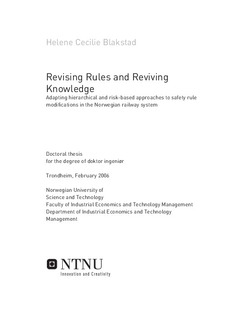| dc.description.abstract | The study is about safety rule revision with hierarchical and risk-based approaches in the Norwegian railway system. The two approaches represent a change in the rule modification tradition of this system. The overall research question is:
How did the Norwegian railway system respond to new requirements for safety rule modifications?
The study gives special attention to the influence of modification processes upon railway knowledge.
There are three objectives for the study. One objective is to provide descriptions of modification processes that can contribute to increased understanding of these. This includes revealing how problems and roles are framed and to contribute to the building of repertoires of how such processes can be run (Schön, 1991). Another objective is to compare the descriptions with theory. A third objective is to discuss implications of the study.
For these purposes four rule modification processes of the Norwegian railway system have been studied. The study has applied an explorative and qualitative approach. The main sources for information have been interviews with participants of the modification processes and documents developed by the projects. The study was performed in the last phase of the processes. Accordingly, the study looks at the modification processes from the perspective of the participants of the studied processes as experienced in their last period of their work.
The main conclusion of the study is that the four modification processes abandoned the intentions of hierarchical and risk-based approaches. First, they did not develop outcomeoriented rules on the background of risk analyses. Second, they did not derive prescriptive rules from outcome oriented rules. Third, they did not choose rule solutions where the hierarchy of rule solutions was linked to the positions of rule-imposers in the organizational hierarchy such as had been suggested.
The main reason was that the new approaches did not take existing railway knowledge, that had been found to be important for safe performance, sufficiently into account. Instead, the modification work of all cases turned into processes that are given the name “reverse invention” in the study. Here existing railway knowledge and prescriptive rules were used as a fundament for the work. Accordingly, existing knowledge was brought forth.
The risk analyses supplemented railway knowledge. The four cases integrated the risk analyses in the modification processes in four different ways (See Figures 7.1, 7.2, 7.3, 7.4 in Chapter 7). This gave the analyses different functions in the rule development. The evolving work was evaluated with railway knowledge as a reference and brought in accordance with this knowledge.
The cases favored solutions that took advantage of different perspectives upon rationality and knowledge. However, existing railway knowledge, including existing prescriptive rules, appeared remarkably persistent compared to the expectations for the work. Furthermore, the modification processes contained mechanisms that validated this knowledge.
The new approaches and the processes of reverse invention raised questions that initiated inquiries into railway knowledge. These inquiries revived this knowledge. It remained uncertain whether the potential of inquires for organizational learning resulted in actual new knowledge.
However, the rationalistic ideals of new approaches stimulated a reduction of the revived railway knowledge into more rationalistic theoretical forms, i.e. relational and contextual elements were removed. Theory argues that the latter knowledge is important for the ability to decode theoretical knowledge for future use and to judge its relevance (Stein, 1995; Baumard, 1999; Nonaka & Takeuchi, 1995). The benefit of revived knowledge might therefore be lost in the future. The study outlines some solutions for counteracting such a negative development.
At the end of the study the implications of this conclusion are discussed. Also, links to theory and needs for further research are elaborated upon. | nb_NO |
